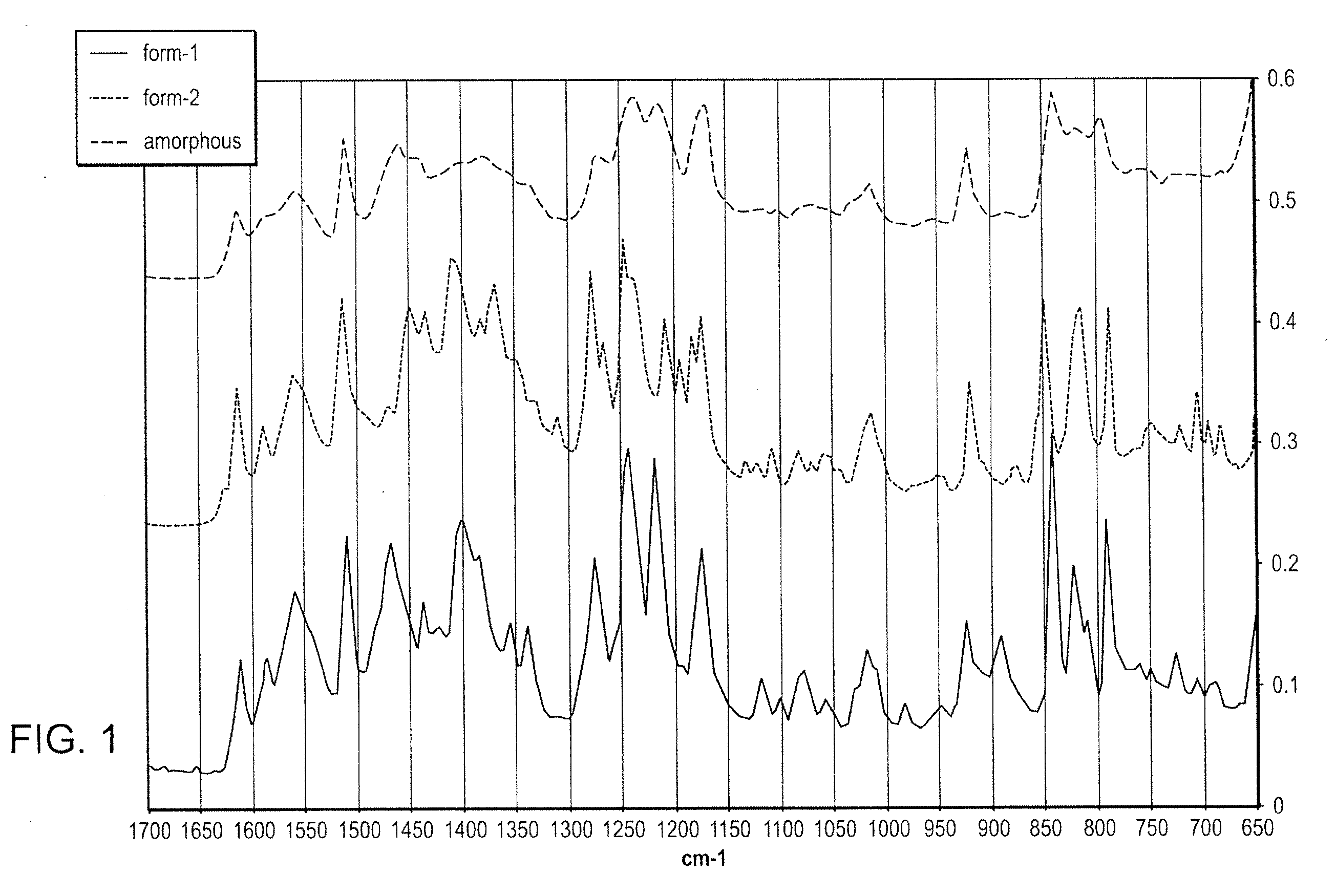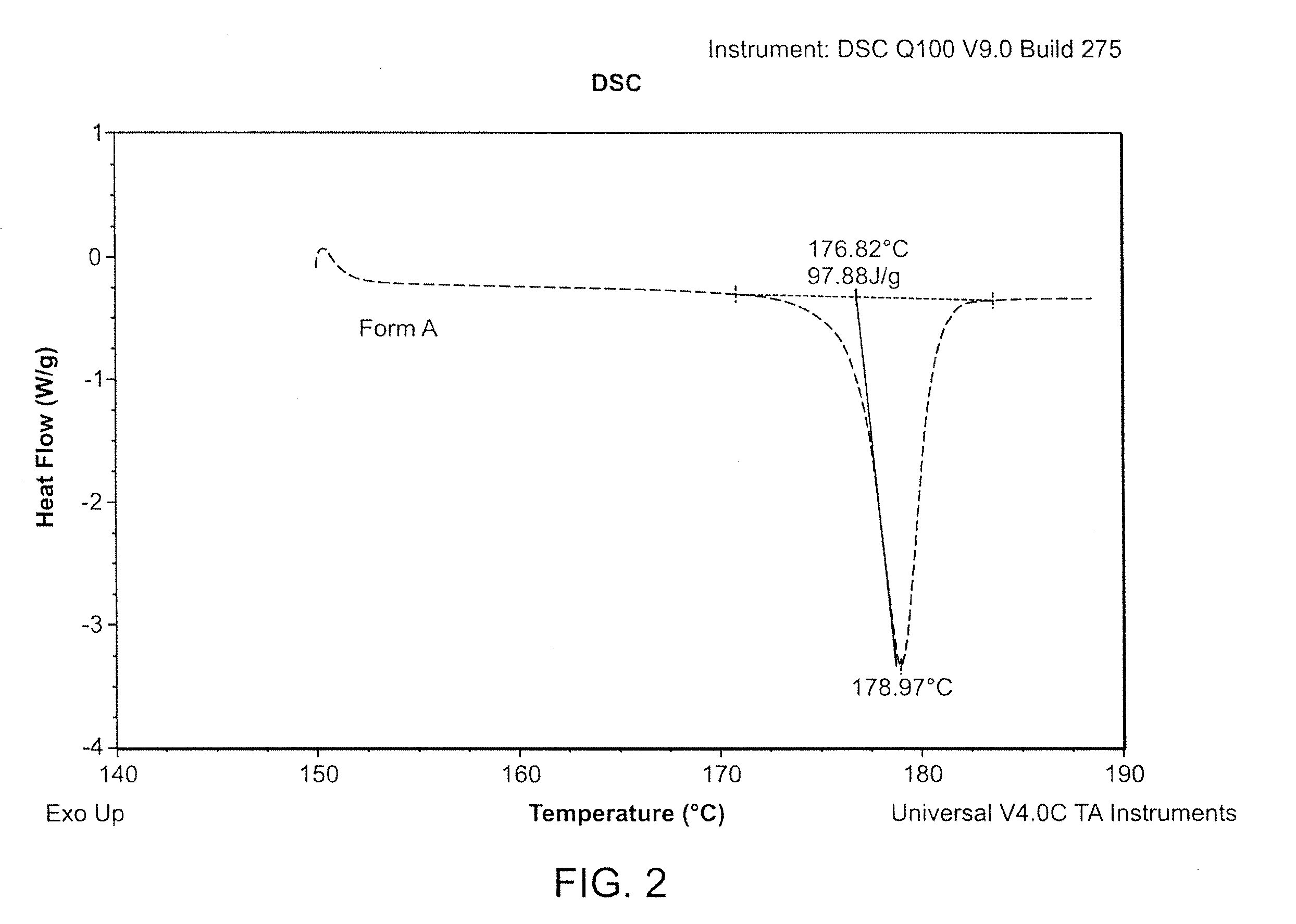Methods of converting polymorphic form b of bazedoxifene acetate to polymorphic form a of bazedoxifene acetate
- Summary
- Abstract
- Description
- Claims
- Application Information
AI Technical Summary
Problems solved by technology
Method used
Image
Examples
example 1
Infrared (IR) Analysis of Polymorphic Form A and Form B of Bazedoxifene Acetate
[0067]The solid state of both polymorphic Form A and Form B of Bazedoxifene Acetate has a characteristic Infrared (IR) spectrum. The transformation from Form A to Form B can be followed “on-line” by FT-IR / ATR and FBRM technology (Lasentec probe). The “IR on-line” experiments can be carried out using the system React-IR 4000 in the configuration that uses the probe with diamond sensor ATR (Dicomp). The “size-distribution on line” experiments are executed by using the system Lasentec FBRM equipped with D600R probe.
[0068]IR measures are carried out opportunely placing a few mg of the powder of the sample on the diamond sensor ATR of the probe. The inquired spectral interval is 4000-650 cm-1 with 4 cm-1 resolution (128 scans for every collected spectrum). Some experiments are executed creating an ethanol vapor atmosphere around the ATR sensor avoiding the direct contact between the liquid solvent and the powd...
example 2
Differential Scanning Calorimetry (DSC) Analysis of Polymorphic Form A and Form B of Bazedoxifene Acetate
[0070]Differential scanning calorimetry (DSC) is conducted with aluminum hermetic pans, generally in the temperature interval of 150-190° C. at 5° C. / min. Form A and Form B can be distinguished by their respective melting point. The DSC results are summarized in Table 2. FIG. 2 is a DSC thermogram for polymorphic Form A of bazedoxifene acetate. FIG. 3 is a DSC thermogram for polymorphic Form B of bazedoxifene acetate. FIG. 4 shows an overlay of DSC thermograms for polymorphic Form A and Form B of bazedoxifene acetate.
TABLE 2Solid stateOnset (° C.)*Peak (° C.)*Energy (J / g)*Form A176.0-177.0178.0-179.0Endo 95-100Form B180.5-181.5182.0-182.8Endo 115-120*Medium values from repeated analysis on samples considered pure polymorph and on HPLC specification.
[0071]The DSC technique can be used to quantitatively determine the presence of polymorphic Form B of bazedoxifene acetate in batches...
example 3
Thermogravimetric Analysis (TGA) of Polymorphic Form A and Form B of Bazedoxifene Acetate
[0072]Thermogravimetric Analysis (TGA) is conducted with a platinum pan in the temperature range of 25°-280° C. at 4° C. / min. in modality “High-Res TGA”. During the heating (in an open system), polymorphic Form A and Form B of bazedoxifene acetate release acetic acid above 100° C., and goes to completion generally between 235° and 245° C. The amount of the weight loss is between 11 and 12% and correspond to acetic acid of neutralization (theoretical 10.8%). The TGA profile of the acetic acid loss of Form A and Form B is subdivided into three fractions. The quantity of each fraction is characteristic of every single batch. FIG. 6 shows a TGA curve for polymorphic Form A of bazedoxifene acetate. FIG. 7 shows a TGA curve for polymorphic Form B of bazedoxifene acetate.
PUM
| Property | Measurement | Unit |
|---|---|---|
| temperature | aaaaa | aaaaa |
| temperature | aaaaa | aaaaa |
| temperature | aaaaa | aaaaa |
Abstract
Description
Claims
Application Information
 Login to View More
Login to View More - R&D
- Intellectual Property
- Life Sciences
- Materials
- Tech Scout
- Unparalleled Data Quality
- Higher Quality Content
- 60% Fewer Hallucinations
Browse by: Latest US Patents, China's latest patents, Technical Efficacy Thesaurus, Application Domain, Technology Topic, Popular Technical Reports.
© 2025 PatSnap. All rights reserved.Legal|Privacy policy|Modern Slavery Act Transparency Statement|Sitemap|About US| Contact US: help@patsnap.com



